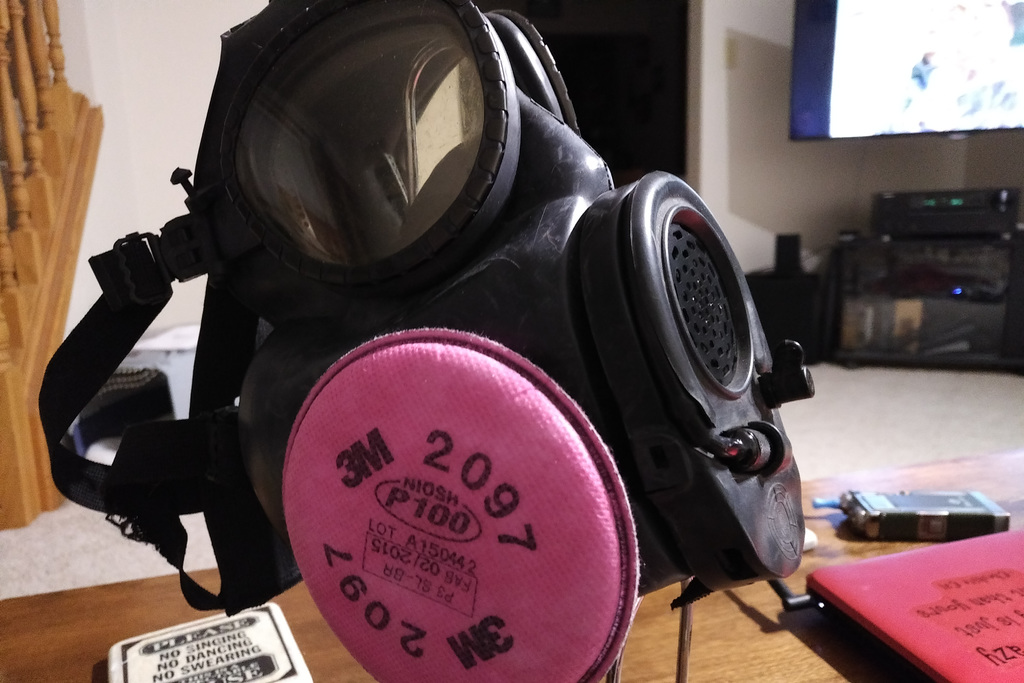
3M filter adapter for M17 gas masks
thingiverse
Threaded adapters for M17 gas mask allow connecting 3M bayonet lug filters. The reason is that the M17 is more comfortable on me when it's not extremely hot. I probably don't need to say this, but using these parts won't pass any certifications and won't meet OSHA or anyone else's compliance requirements. If you're intending to use this for personal protection around your home, I wish you the best of luck, but you should test it thoroughly. On a proper 3M mask, the inside surface of the filter's mounting hub squeezes a rubber lip against the hard plastic frame of the bayonet assembly. We merely tighten the hard plastic filter mounting hub against the printed (hard) top rim of the porkchop's stem. This appears to be good enough for me, but you should test it and add a seal if necessary. A flat O-ring with an ID of 22 or 23mm should work. In the future, I will probably add a fitting for NATO cans with 40mm threads, Russian cans with 39.7mm threads, and possibly for a NATO gas mask hose. __UPDATED - 2020-04-07__ The combined left and combined right .STL files are one-piece porkchops with integrated 3M bayonet adapters - sized for 3mm O-rings. You still need to install the inhalation valves, but you can then feed the whole thing into your cheek pockets and directly attach 3M disc or cartridge filters with no other adapters. The mask with disc filters attached still fits pretty easily into the standard-issue mask pouch. With cartridges attached, I was barely able to stuff it in and close the flap, but I don't recommend it. P026_revised.scad can be edited to adjust the fit. If you are using smaller O-rings, you'll need to edit line 16. 7.5mm is a good fit for 3mm O-rings (cross section diameter), but if you use something else, you can edit it there. As always, stem_height and stem_dia can be tweaked to fit your specific mask. The values in the file give me a good tight seal on my mask, but yours may vary. The inhalation valve body needs to be threaded into the porkchops first. Once you've got it started and straight, you can use a 10mm hex key from the stem side - turn left to tighten. Or, you can use a needle nose plier as a wrench - just be careful that you don't mar the surface. Once the valve body is installed, you can insert the stem of the valve through the center hole, and insert the whole thing into the mask's cheek. One of the parameters in Kirchner's threads library is "inside" which changes the clearances. I can't get a part made with external threads to thread into a hole made with internal threads, even with the adjusted clearances. Instead, I have to undersize the male parts. 1.0mm undersize threads easily. 0.5mm is too stiff, leaving a joint that requires more force to tighten than I can apply without damage. 1.0 is a good choice for the inhalation valve bodies - the parameter inner_thread_clearance. For the bayonet adapters, you will need to tweak the outer_thread_clearance variable. It needs to be loose enough that you can install the parts, but (ideally) tight enough that they don't turn when you attach/detach a filter. If the bayonet adapter is too loose, you can use the filter itself as a wrench to tighten it up when you install it. Unfortunately, you can also use the filter as a wrench when you remove it, which can be very annoying. You select the part you need by uncommenting a line near the top. The porkchops refuse to render in preview mode, and full compiled rendering takes a long time. In the future, I will probably add a fitting for NATO cans with 40mm threads, Russian cans with 39.7mm threads, and possibly for a NATO gas mask hose.
With this file you will be able to print 3M filter adapter for M17 gas masks with your 3D printer. Click on the button and save the file on your computer to work, edit or customize your design. You can also find more 3D designs for printers on 3M filter adapter for M17 gas masks.
